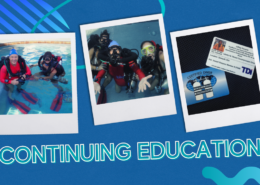3 Mistakes Most New and Veteran Divers Make
by Jon Kieren
We all make mistakes, it is human nature. Fortunately, within the scope of sport diving, many of those mistakes are pretty quick and easy fixes. However, it’s important to recognize that the mistake has occurred and adjust future diving practices in order to prevent the same mistake from becoming a part of a bigger error chain that results in a serious accident. This article will discuss 3 mistakes that are common for new divers, how to avoid them, and how an experienced diver could easily end up making the same mistake.
1st mistake – Forget to turn on air – It’s frightening how often this actually happens, and any diver who claims they’ve never done it themselves is probably not being 100% truthful. Many new divers are either very excited or very nervous to go diving, and it’s easy to miss a step in their pre-dive checks. Most of the time a Divemaster or crew member will catch the mistake before the diver enters the water, or the diver turns to a buddy on the surface and asks them to turn it on for them, and there is not an issue. But what if they also forgot to put air in their BCD or they are diving over-weighted? They can easily end up below the surface and negatively buoyant without something to breathe, a bad situation for anyone to be in.
- How to avoid – Conduct a proper pre-dive check before every single dive, NO EXCEPTIONS.
- How an experienced diver can make the same mistake – Complacency. Many experienced divers see doing pre-dive checks as a sign of inexperience, and have gotten away with eliminating them from their routine. “I’ve done hundreds of dives; I think I’m smart enough to not jump in the water without my air on.” Until they’re not, and end up in the same situation as the new diver above.
2nd mistake – Run low on air – Just like the previous point, newer divers are usually either excited or nervous to be underwater. They are busy focusing on all the new and exciting critters, and forget to monitor things like time, depth, and gas supply. Because they are new and excited, they burn through their gas supply quicker than the rest of the group. Even though their buddies still have plenty of air, the new diver can easily find themselves close to or completely out while still on the bottom.
- How to avoid – Keep your priorities straight. If you’re swimming underwater, there’s a pretty good chance you are relying on an external gas supply in order to survive. You need to know how much you have at all times by closely monitoring your gauges. Above everything else on a dive, you need to always know three things: how much gas you have, what depth you’re at, and what your no decompression limit is; everything else is secondary. Don’t push it to the edge, if you have an emergency at the end of the dive, you’ll need a little time to sort it out. While underwater, more air is the only thing that can provide you that extra time.
- How an experienced diver can make the same mistake – Complacency. Many experienced divers push their gas supply to the edge. If they’ve never had a hose fail or a regulator free flow, they probably don’t truly understand just how much gas they will lose in those situations, and will assume it’s okay to breathe their tank near empty. Then when they do have a problem at the end of a dive, they don’t have the time to sort it out.
3rd mistake – Dive over-weighted – Unfortunately, it is very common for inexperienced instructors to over-weight new student divers. This carries on post-certification, and many new divers wind up dangerously over-weighted, making neutral buoyancy nearly impossible to achieve and maintain.
- How to avoid– If you are one of the unlucky divers who was not taught proper weighting and buoyancy control, this may require a little remedial training. Find an instructor/mentor who is willing and able to help you fine tune your weighting, buoyancy, and trim.
- How an experienced diver can make the same mistake – Laziness. Instead of working on fine tuning their buoyancy skills, many experienced divers will add extra lead to make it “easier to stay down,” not understanding how that extra weight destroys their trim, buoyancy control, and air consumption rate. The optimal situation is to be perfectly neutral at your safety stop at the end of a dive with nearly no gas in your BCD.
While this is far from a complete list of common mistakes new and experienced divers make, you can begin to see a pattern forming. Many of the simple, basic, most obvious mistakes most newbie divers make end up coming back full circle and biting some of the most experienced divers. As a new diver, take it slow, remember your training, keep your priorities straight, and focus on the basic skills… and you will avoid many of these mistakes. As an experienced diver, take it slow, remember your training, keep your priorities straight, and focus on the basic skills… and you will avoid the laziness and complacency that can lead to serious accidents.
Find your local SDI Dive Center to brush up on your training!











Leave a Reply
Want to join the discussion?Feel free to contribute!